Arunachal Pradesh, situated in the northeastern region of India, is a hub for birdwatchers and ornithologists. It is home to an array of avian species from the elusive and endangered to the commonly seen.
The state’s diverse landscape and vegetation provide an ideal habitat for hundreds of bird species. The forests are a treasure chest of exotic bird species, some of which are endemic to this region.
The bird list of Arunachal Pradesh includes a wide array of birds including the Himalayan Monal, Rufous-necked Hornbill, and the rare purple cochoa.
With its unique biodiversity, Arunachal Pradesh deserves a place on every birder’s bucket list.
1. Crimson-Breasted Woodpecker

The Crimson-breasted Woodpecker is a beautiful bird found in parts of Asia. It has bright red and black plumage, with its chest being the brightest part of its body.
These birds are typically seen foraging on tree trunks or branches in search of food such as insects and other invertebrates.
They are also known to feed on small fruits and seeds from trees, helping to disperse them throughout their habitat.
The species prefers moist lowland forests or montane forests at higher elevations where they can find plenty of food sources near each other.
While this woodpecker’s population appears stable overall, conservation efforts should still be taken to ensure that it continues to flourish in all areas it inhabits.Scientific classification:
| Kingdom | Animalia |
| Phylum | Chordata |
| Class | Aves |
| Order | Piciformes |
| Family | Picidae |
| Genus | Dryobates |
| Species | D. cathpharius |
Also Featured In: Most Common Birds in China,
2. Greater Coucal
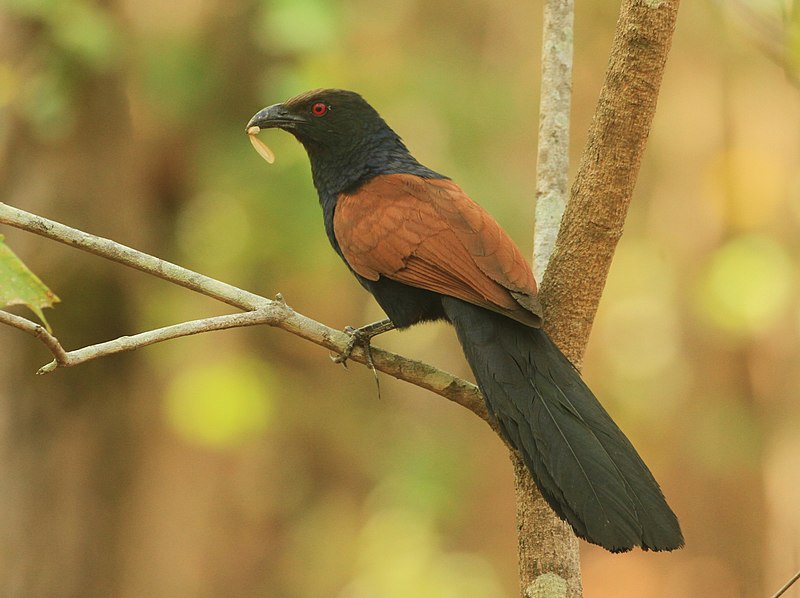
The Greater Coucal is a large, crow-like bird that belongs to the Cuculiformes order. It has a long tail and coppery brown wings.
These birds are found in many habitats across India and Southeast Asia, ranging from jungles to suburban gardens.
They feed on insects as well as small vertebrates such as frogs, lizards or snakes which they capture with their strong beak.
The males have glossy black plumage while females are dark brown above with buff underparts.
During breeding season these birds make loud croaking calls and can often be heard at night when they become active after sundown looking for food sources like termites or grasshoppers between bushes or low branches of trees close by water bodies like rivers, lakes etc.
This species plays an important role in maintaining ecological balance in its habitat by controlling pest populations through predation so it is essential that we protect them from hunting and other threats for future generations to enjoy.Scientific classification:
| Kingdom | Animalia |
| Phylum | Chordata |
| Class | Aves |
| Order | Cuculiformes |
| Family | Cuculidae |
| Genus | Centropus |
| Species | C. sinensis |
Also Featured In: Common Birds in India, Birds of Goa
3. Black-Necked Crane
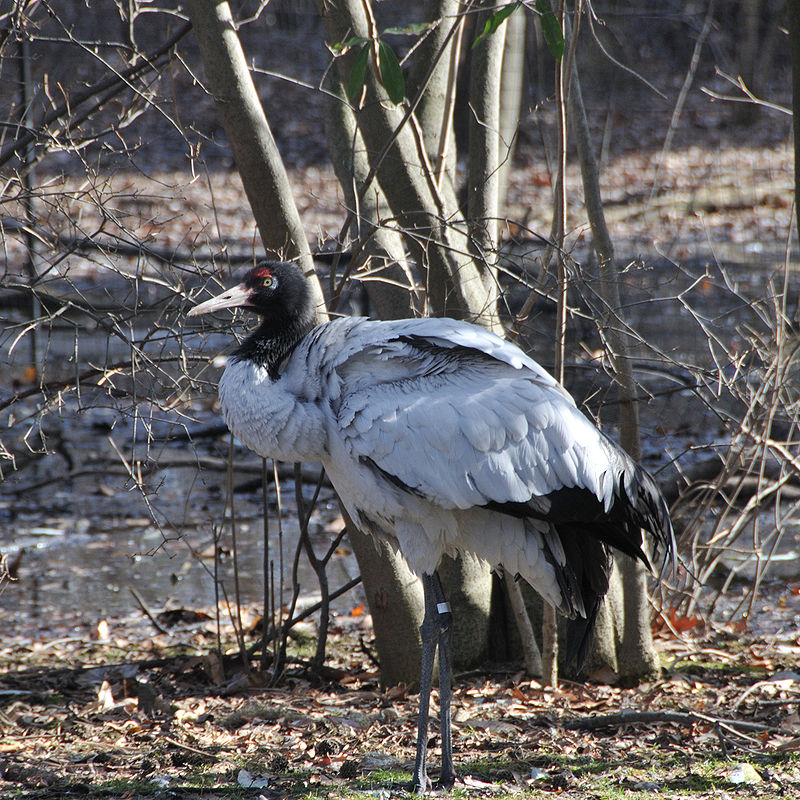
The Black-necked Crane is a majestic bird found in Asia. It has an impressive wingspan of 235cm and stands up to 139 cm tall.
Its feathers are whitish grey with beautiful black markings – head, neck and legs as well as the primaries and secondaries on its wings.
The white patch towards the back of its eye adds to their distinctiveness making them easily recognizable.
They can be seen flying gracefully over Tibet Plateau, India or Bhutan where they breed during summer months before migrating southwards for wintering grounds closer to sea level areas like Assam Valley in North East India.Scientific classification:
| Kingdom | Animalia |
| Phylum | Chordata |
| Class | Aves |
| Order | Gruiformes |
| Family | Gruidae |
| Genus | Grus |
| Species | G. nigricollis |
Also Featured In: Asian Birds, Birds of Ladakh
4. Blue-Naped Pitta
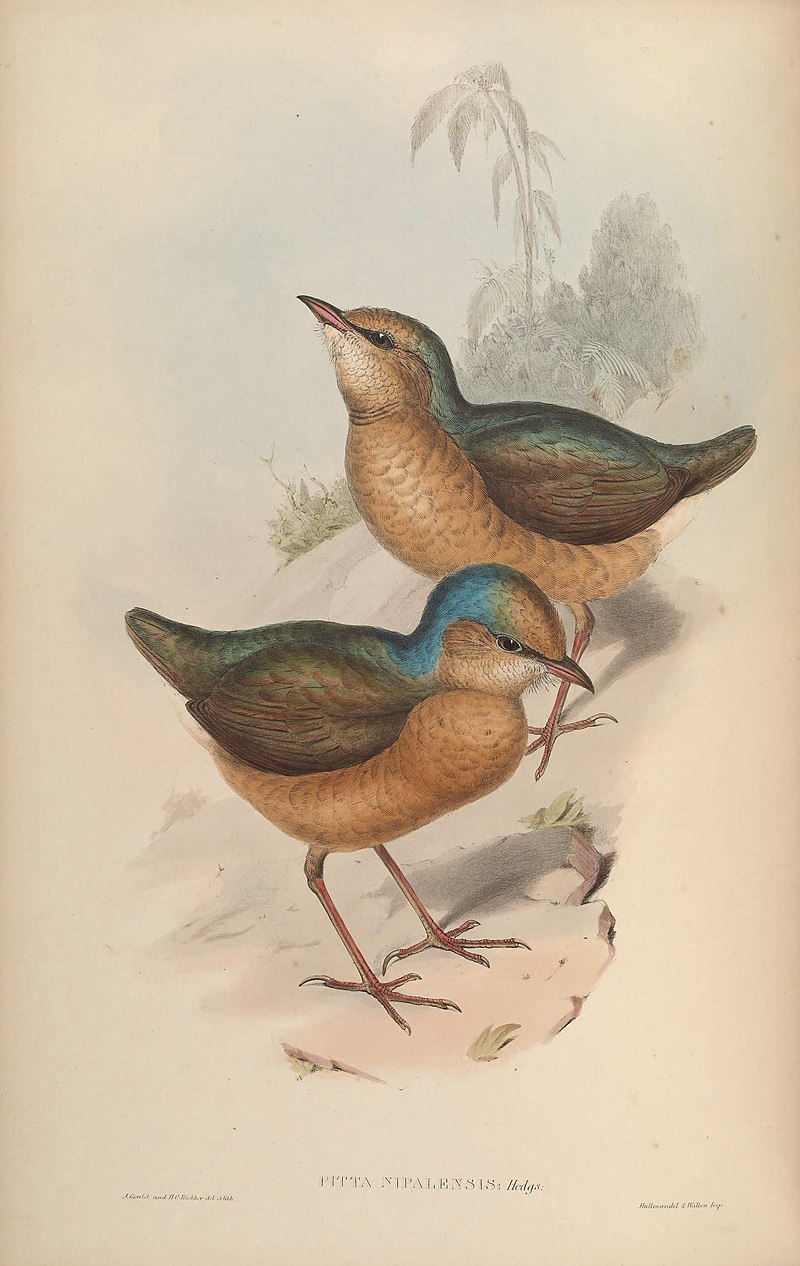
The Blue-naped Pitta is a beautiful species of bird belonging to the family Pittidae. It stands out for its bright colors, including blue and green above, with reddish-yellow coloring below.
The nape and hindneck are particularly striking in their vibrant blue hue while the tail is brown mixed with some green.
Male and female birds look similar but there’s one key difference: females have a reddish-brown hindcrown instead of blue.
This pitta can be found mainly throughout Southeast Asia in habitats such as tropical lowland forests or woodlands near rivers and streams where they feed on insects like beetles, grasshoppers, caterpillars and ants among other small invertebrates that live amongst foliage or on the ground surface.Scientific classification:
| Kingdom | Animalia |
| Phylum | Chordata |
| Class | Aves |
| Order | Passeriformes |
| Family | Pittidae |
| Genus | Hydrornis |
| Species | H. nipalensis |
Also Featured In: Most Common Types of Bangladeshi Birds, Birds That You’ll See in Kaziranga National Park
5. White-Winged Duck
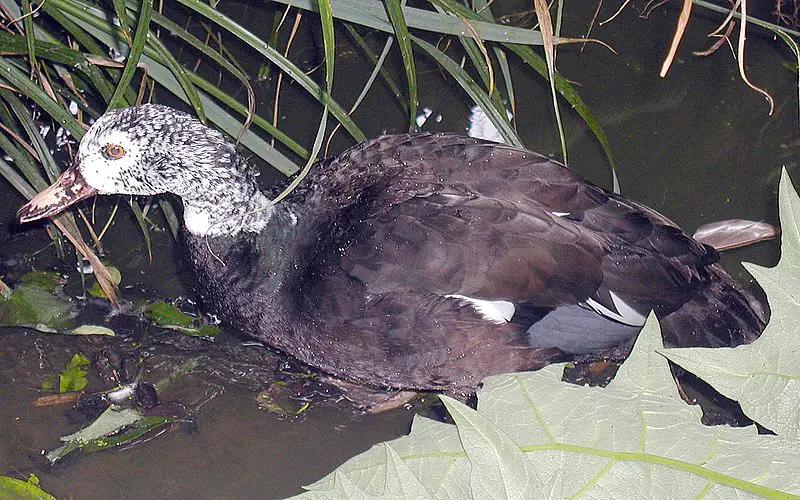
The white-winged duck is a large species of bird once classified in the same genus as Muscovy ducks.
It has distinctive white wing feathers and is otherwise mainly brown with some darker patches on its wings, back and head.
These birds are found primarily in tropical southern Asia, where they inhabit lakes, rivers and wetlands.
They feed mostly on aquatic plants but may also take insects or small fish when available.
Despite their size, these ducks fly well – although not for long distances – making them an impressive sight to behold when taking off from water bodies.Scientific classification:
| Kingdom | Animalia |
| Phylum | Chordata |
| Class | Aves |
| Order | Anseriformes |
| Family | Anatidae |
| Genus | Asarcornis Salvadori, 1895 |
| Species | A. scutulata |
Also Featured In: Most Common Birds of Ko Samui,
6. Hornbill
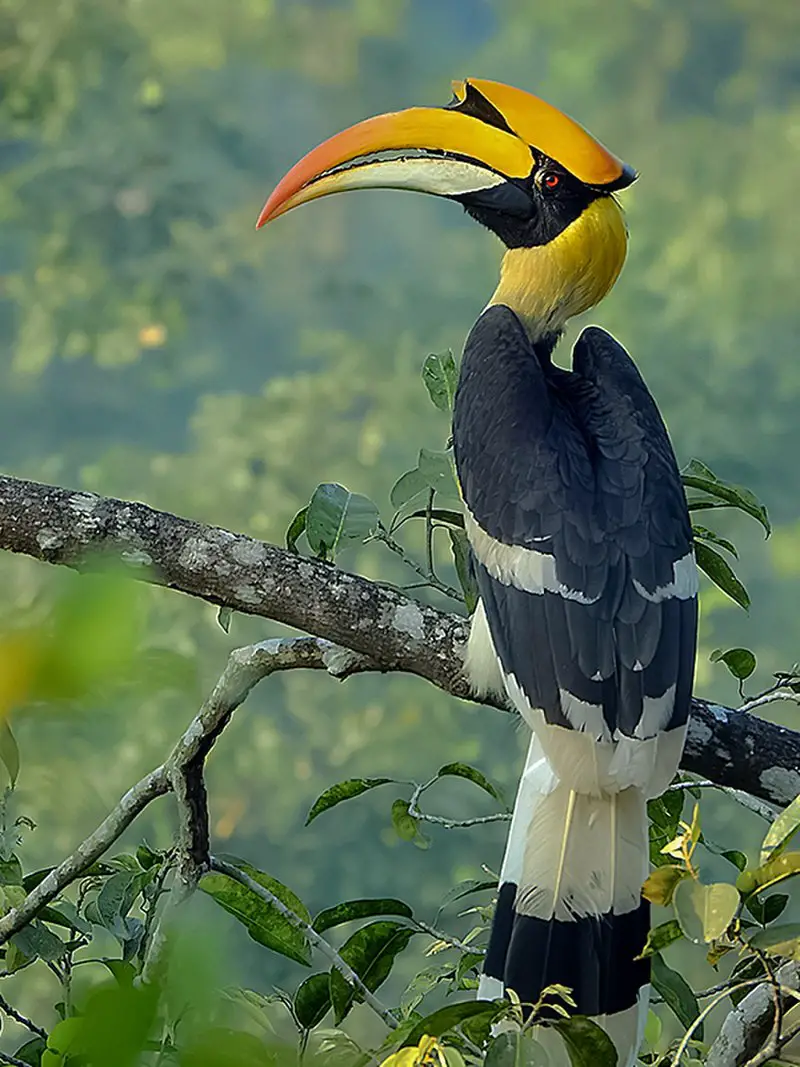
Hornbills are a tropical and subtropical bird species with characteristic long, curved bills. Their English and scientific names both refer to the shape of their bill which resembles that of a cow’s horn.
They have strong beaks for cracking open hard-shelled fruits as well as powerful wings for flying between trees or over great distances in search of food or mates.
Hornbills also feature beautiful plumage ranging from white to black feathers with yellow, brown, red and blue accents on the head, neck and back areas depending on the species.
In addition they often display brightly coloured casques – helmet like structures – atop their upper mandible adding further visual appeal to these majestic birds.Scientific classification:
| Kingdom | Animalia |
| Phylum | Chordata |
| Class | Aves |
| Order | Bucerotiformes |
| Family | Bucerotidae Rafinesque, 1815 |
Also Featured In: Birds of South African, Birds That Live in the Jungle
7. Great Hornbill
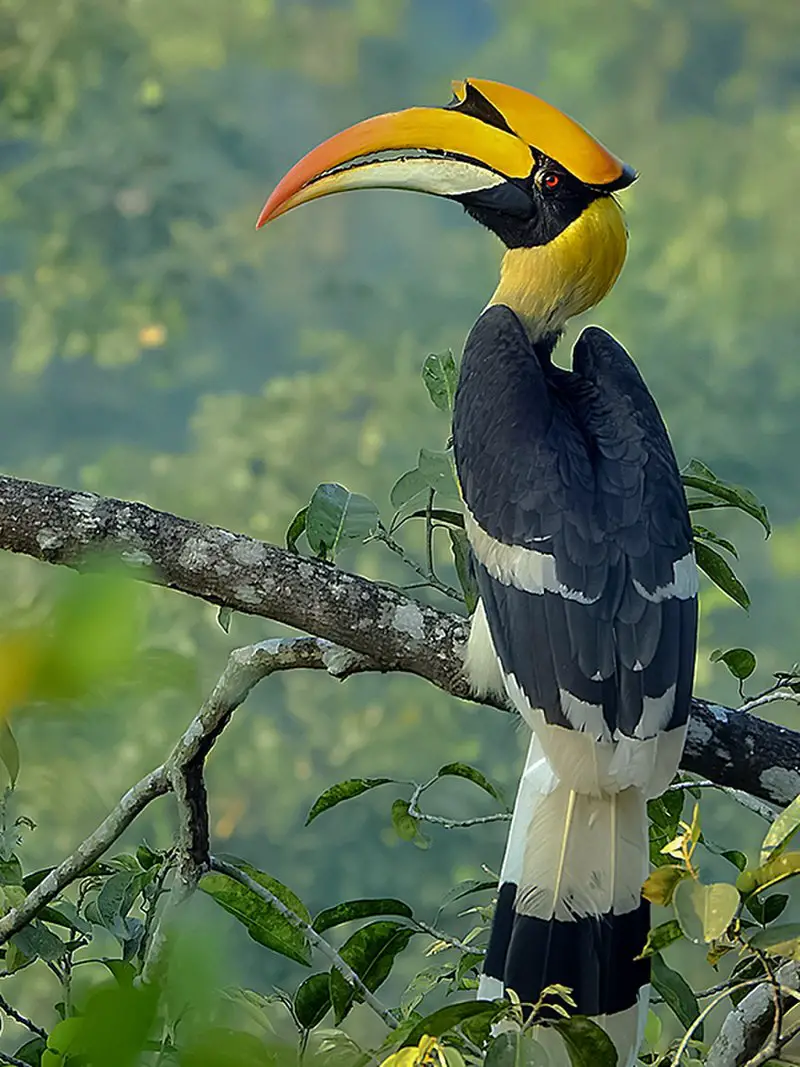
The Great hornbill is an impressive bird, belonging to the family of Hornbills. It can be found in India and Southeast Asia, mainly eating fruits but also preying on small mammals, reptiles and birds.
Its striking looks include a concave casque which sits atop its head as well as vibrant yellow-orange feathers covering much of its body.
Unfortunately it’s listed by IUCN Red List since 2018 due to habitat loss resulting from deforestation for agriculture and timber logging activities taking place across the world today.
Despite this sad news there are still conservation measures being taken such as education programs focusing on sustainable farming practices that will help protect this amazing species’ future.Scientific classification:
| Kingdom | Animalia |
| Phylum | Chordata |
| Class | Aves |
| Order | Bucerotiformes |
| Family | Bucerotidae |
| Genus | Buceros |
| Species | B. bicornis |
Also Featured In: Birds of Myanmar, Common Tropical Rainforest Birds
8. Maroon Oriole
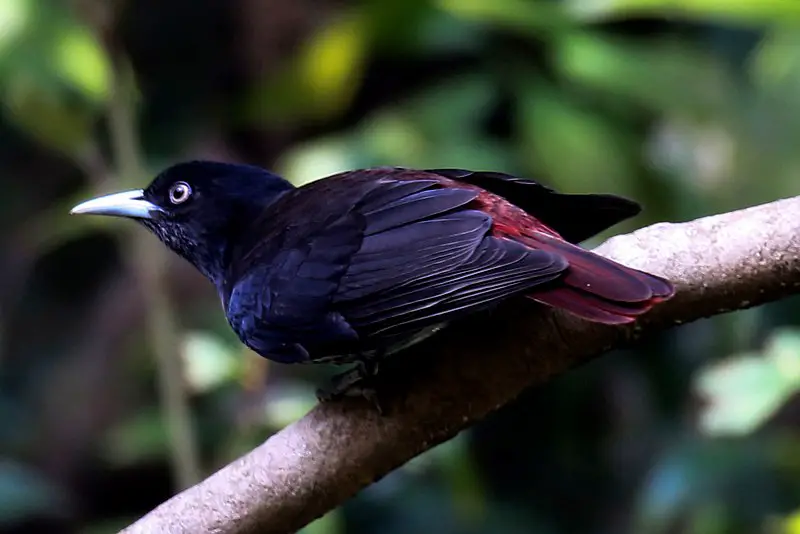
The Maroon Oriole is a species of bird belonging to the family Oriolidae, found in Southeast Asia. Its plumage consists of maroon and black colors along with a black head, neck, breast and wings.
It belongs to a clade that includes four other orioles such as the Black-and-Crimson Orioles and Silver Orioles.
In addition it was originally described under the genus Pastor when first discovered by scientists during its classification process.
The Maroon Oriole lives mainly on fruits but will also eat insects or small lizards if available for food sources; this makes them omnivorous creatures which can adapt to different situations according to their environment’s needs.
Their diet has made them quite popular among both local people living nearby as well as tourists who are looking for an interesting sighting while visiting these regions.Scientific classification:
| Kingdom | Animalia |
| Phylum | Chordata |
| Class | Aves |
| Order | Passeriformes |
| Family | Oriolidae |
| Genus | Oriolus |
| Species | O. traillii |
9. Bay Woodpecker
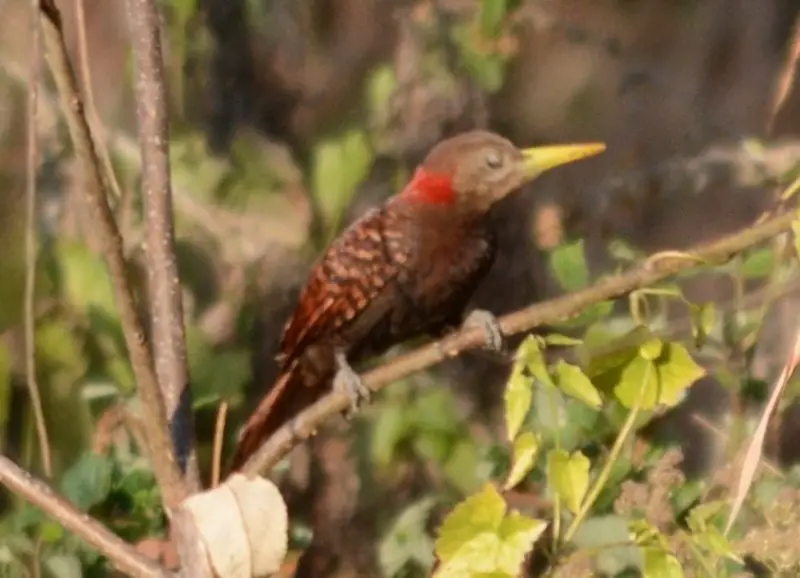
The Bay Woodpecker is a species of bird found in many parts of Asia, from Bangladesh to Vietnam. This small but colorful bird lives in subtropical or tropical moist lowland and montane forests.
It has an olive-brown back with white barring on the wings and tail feathers, while its belly is yellowish-white spotted with cinnamon brown. Its diet consists mainly of insects such as ants, beetles, termites and caterpillars.
The call of this woodpecker can be heard echoing through the trees – it’s a loud “krrr” noise.
As well as foraging for food alone or in pairs during the day time, they also use their long bills to excavate nest cavities high up into tree trunks where they lay eggs at night time.
These birds are important seed dispersers due to their constant movement between habitats which helps spread new varieties of plants throughout different areas – making them essential components within local ecosystems.Scientific classification:
| Kingdom | Animalia |
| Phylum | Chordata |
| Class | Aves |
| Order | Piciformes |
| Family | Picidae |
| Genus | Blythipicus |
| Species | B. pyrrhotis |
10. Blyth’s Tragopan
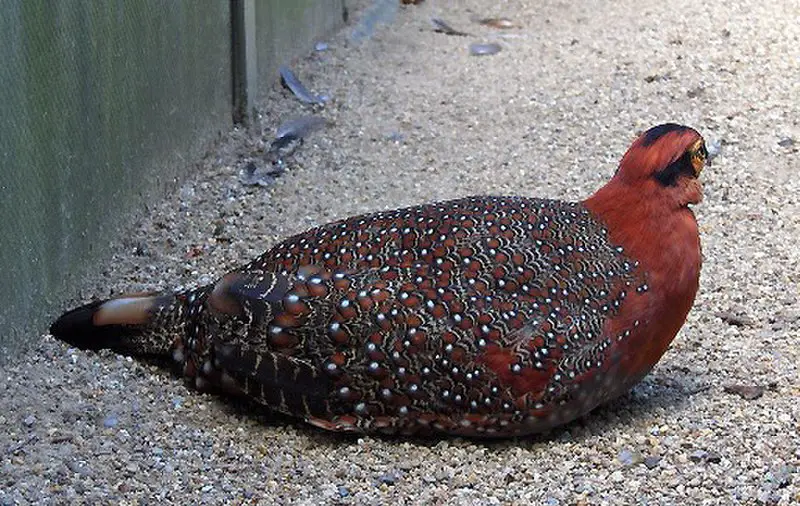
Blyth’s tragopan is a pheasant species that is currently classified as vulnerable. It was named after Edward Blyth, an English zoologist and Curator of the Museum of the Asiatic Society of Bengal in 1810–1873.
This colorful bird has black and white feathers on its wings with grey bellies. The population for this species is small and believed to be decreasing rapidly due to human activity such as habitat destruction and hunting for food or sport purposes.
They can be found in various areas including Bhutan through India up into China, across Southeast Asia towards Thailand, Vietnam and Cambodia.
To conserve these birds it’s essential we protect their habitats by limiting activities like logging which are destroying natural environments where they live while also increasing public awareness about them so people will take more action to help save them from extinction.Scientific classification:
| Kingdom | Animalia |
| Phylum | Chordata |
| Class | Aves |
| Order | Galliformes |
| Family | Phasianidae |
| Genus | Tragopan |
| Species | T. blythii |
11. Black-Eared Shrike-Babbler
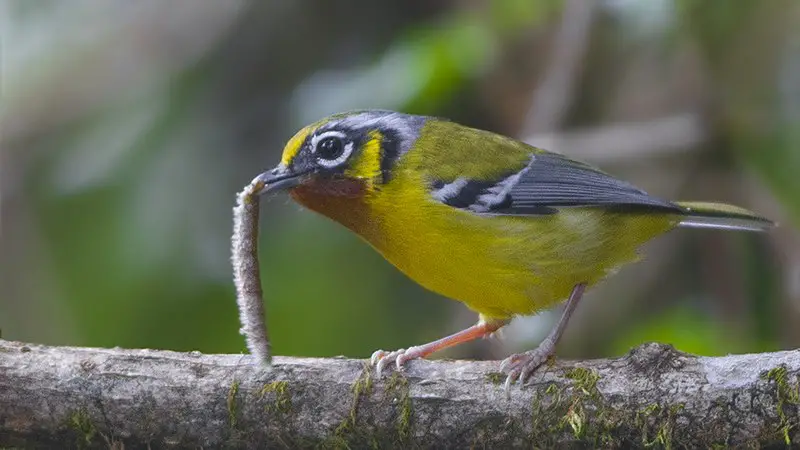
The black-eared shrike-babbler is a species of bird in the Vireonidae family found throughout Southeast Asia, particularly in the Himalayas.
Its behavior and habits resemble those of vireos due to convergent evolution, although it was traditionally considered an aberrant Old World babbler placed within the Timaliidae family.
This small bird has distinct black ear patches with white borders against its brown upperparts and greyish underparts.
It feeds on insects such as grasshoppers, caterpillars and other invertebrates while foraging among foliage or branches near forest edges.
They also eat fruits like figs during winter months when insect availability decreases significantly.
The Black-eared shrike-babbler is usually seen alone or in pairs interacting through calls that create melodious sounds echoing across their native forests habitatsScientific classification:
| Kingdom | Animalia |
| Phylum | Chordata |
| Class | Aves |
| Order | Passeriformes |
| Family | Vireonidae |
| Genus | Pteruthius |
| Species | P. melanotis |
Also Featured In: Common Birds Found in Nepal,
12. Bar-Winged Flycatcher-Shrike
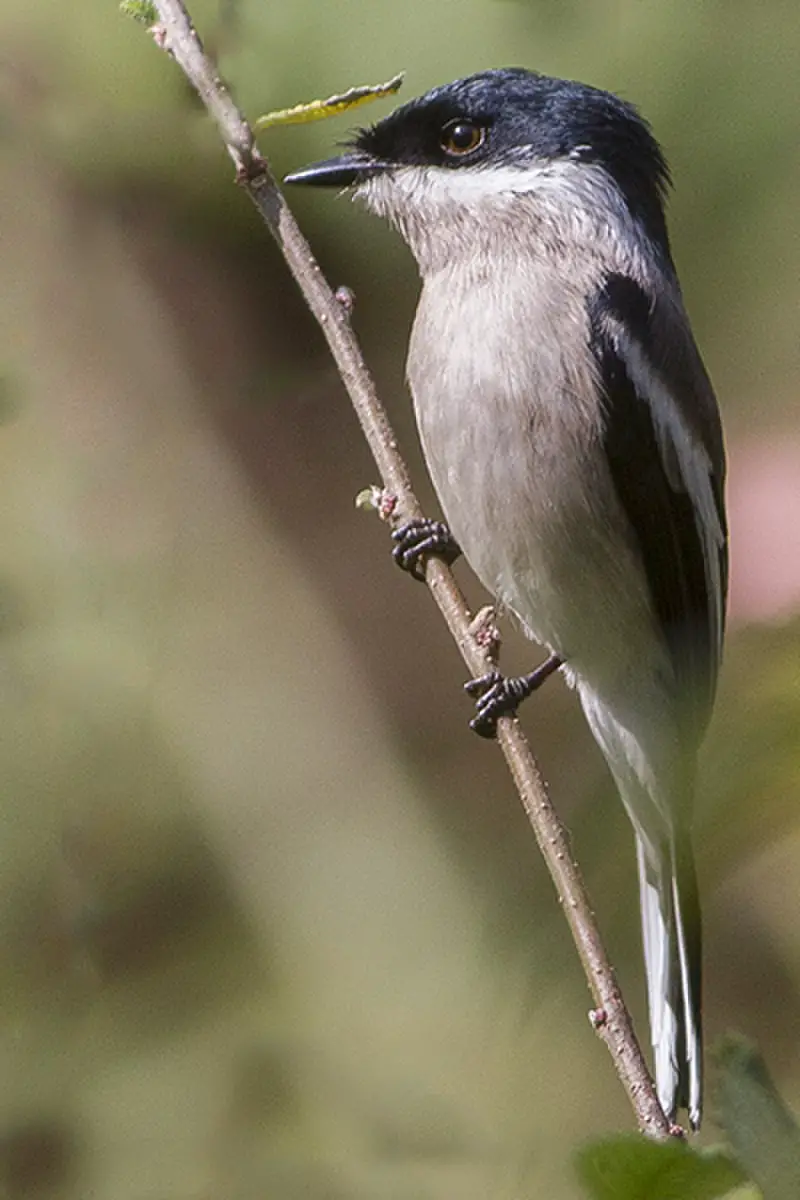
The Bar-winged Flycatcher-Shrike is a small passerine bird found in the forests of tropical southern Asia, ranging from the Himalayas and hills of India to Indonesia.
These birds inhabit mid-canopy levels in the forest, often joining mixed species flocks while they search for food.
With its distinctive pattern of black and white plumage on its head and wings, this flycatcher can be easily identified by experienced bird watchers.
They are mainly insectivorous birds that feed upon insects such as moths, beetles and flies which they capture using their sharp bill or talons during flight.
The bar-winged flycatcher has adapted well to life in these woodlands with an agile nature allowing it to navigate quickly through dense foliage when searching for prey or evading predators.Scientific classification:
| Kingdom | Animalia |
| Phylum | Chordata |
| Class | Aves |
| Order | Passeriformes |
| Family | Vangidae |
| Genus | Hemipus |
| Species | H. picatus |
Also Featured In: Common Birds that Live in Odisha, Birds that Live in Kuala Lumpur
13. Mountain Imperial Pigeon
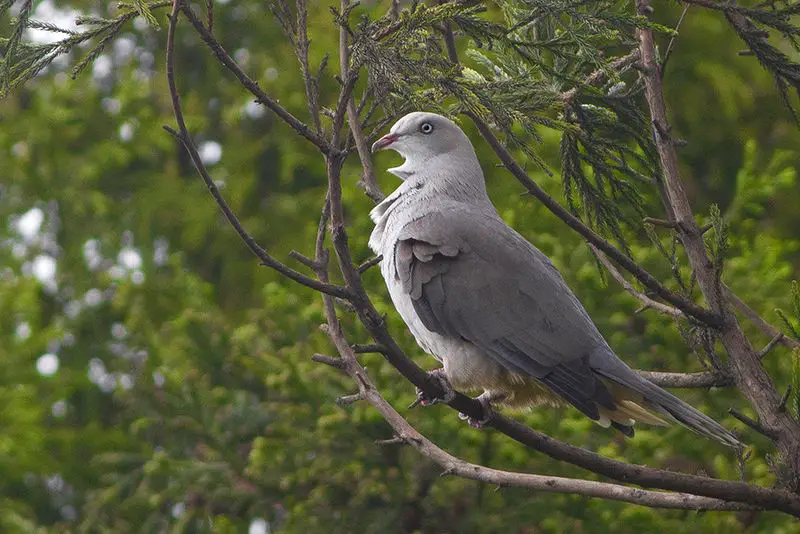
The Mountain Imperial Pigeon is a species of bird in the Dove family, found across Southeast Asia. It has distinct maroon-backed feathers and can be easily recognized by its bright eyes and yellowish bill.
The bird feeds primarily on fruits and nuts from trees, such as figs, mangoes and coconuts. Its habitat consists of tropical forests near mountains or hillsides with plenty of foliage for it to feed on.
Recently, the Malabar Imperial Pigeon was separated into its own species due to differences between them observed in their plumage colouring; they both have similar diets however.
This majestic pigeon stands out amongst other birds due to its striking colours that make it an eye-catching sight within any environment.Scientific classification:
| Kingdom | Animalia |
| Phylum | Chordata |
| Class | Aves |
| Order | Columbiformes |
| Family | Columbidae |
| Genus | Ducula |
| Species | D. badia |
Also Featured In: Singapore Birds, Imperial Birds You Should Know
14. Ward’s Trogon
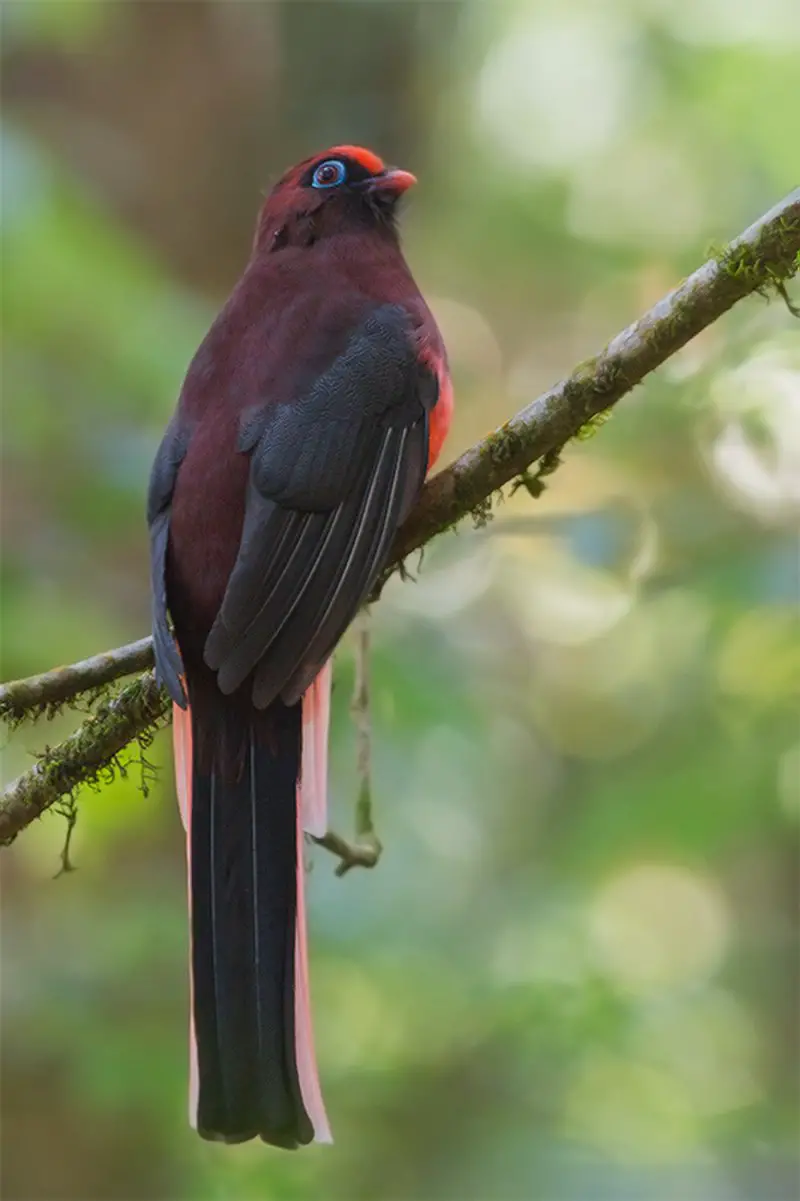
Ward’s trogon is a species of bird found in the northeastern parts of India, Bhutan, Tibet and Myanmar. It has a disjunct population in northern Vietnam but there have been no recent sightings.
This colorful bird inhabits temperate forests as well as subtropical or tropical moist lowland forests up to 10,000 ft above sea level.
Male Ward’s Trogons are most easily identified by their iridescent green upperparts with white underparts and reddish-orange wings; females look similar but lack the orange wing feathers.
They mainly feed on insects such as beetles and cicadas which they catch from branches while perched motionlessly for long periods of time.
Breeding season begins around March when males can be heard singing melodious calls during dawn or dusk hours.Scientific classification:
| Kingdom | Animalia |
| Phylum | Chordata |
| Class | Aves |
| Order | Trogoniformes |
| Family | Trogonidae |
| Genus | Harpactes |
| Species | H. wardi |
Also Featured In: Bhutan birds,
15. Rufous-Necked Hornbill
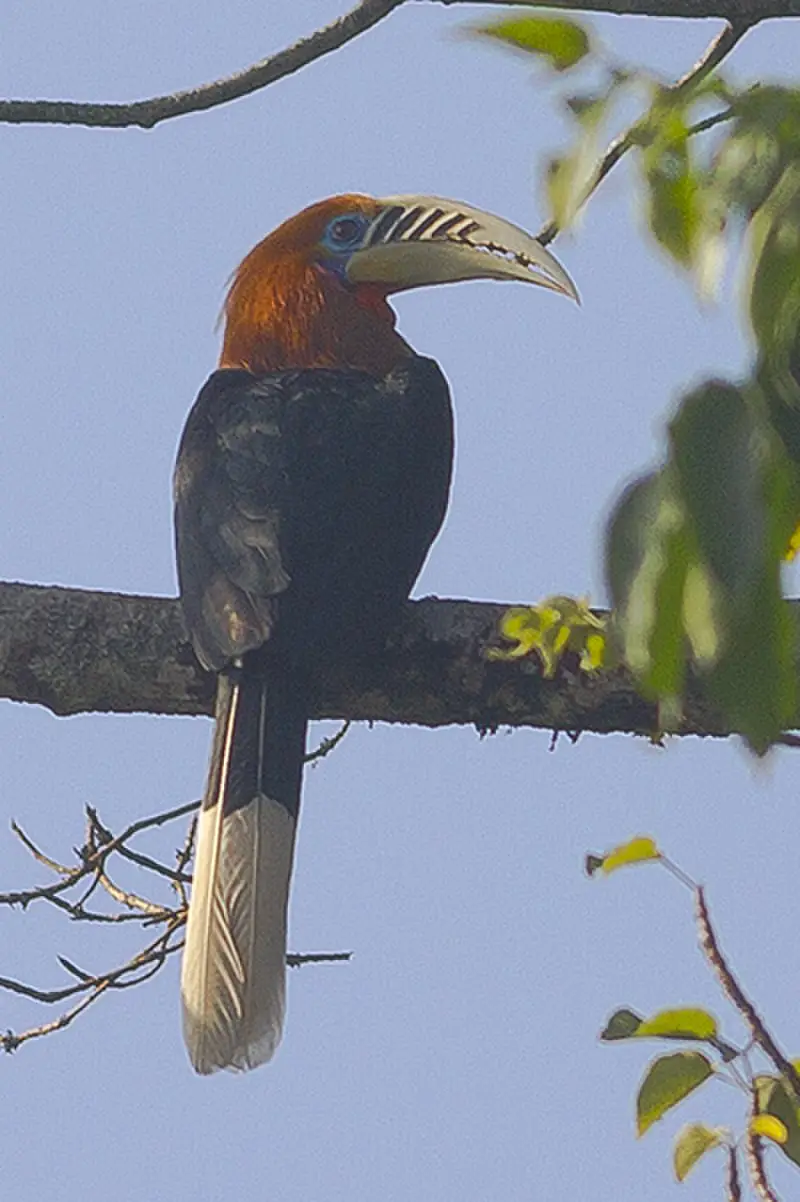
The Rufous-necked Hornbill is a beautiful and majestic bird found in Bhutan, northeastern India, especially Arunachal Pradesh.
It has been sadly declared locally extinct in Nepal as hunting accelerated its decline along with loss of habitat due to human interference.
This large Bucerotine hornbill measures approximately 117 cm long and there are less than 10,000 adults remaining in the wild today.
Its striking plumage consisting of black body feathers edged with white; yellow legs and bill; red throat patch on males (orange for females) make it a truly remarkable sight when seen up close.Scientific classification:
| Kingdom | Animalia |
| Phylum | Chordata |
| Class | Aves |
| Order | Bucerotiformes |
| Family | Bucerotidae |
| Genus | Aceros Gray, 1844 |
| Species | A. nipalensis |
16. Black-Headed Shrike-Babbler
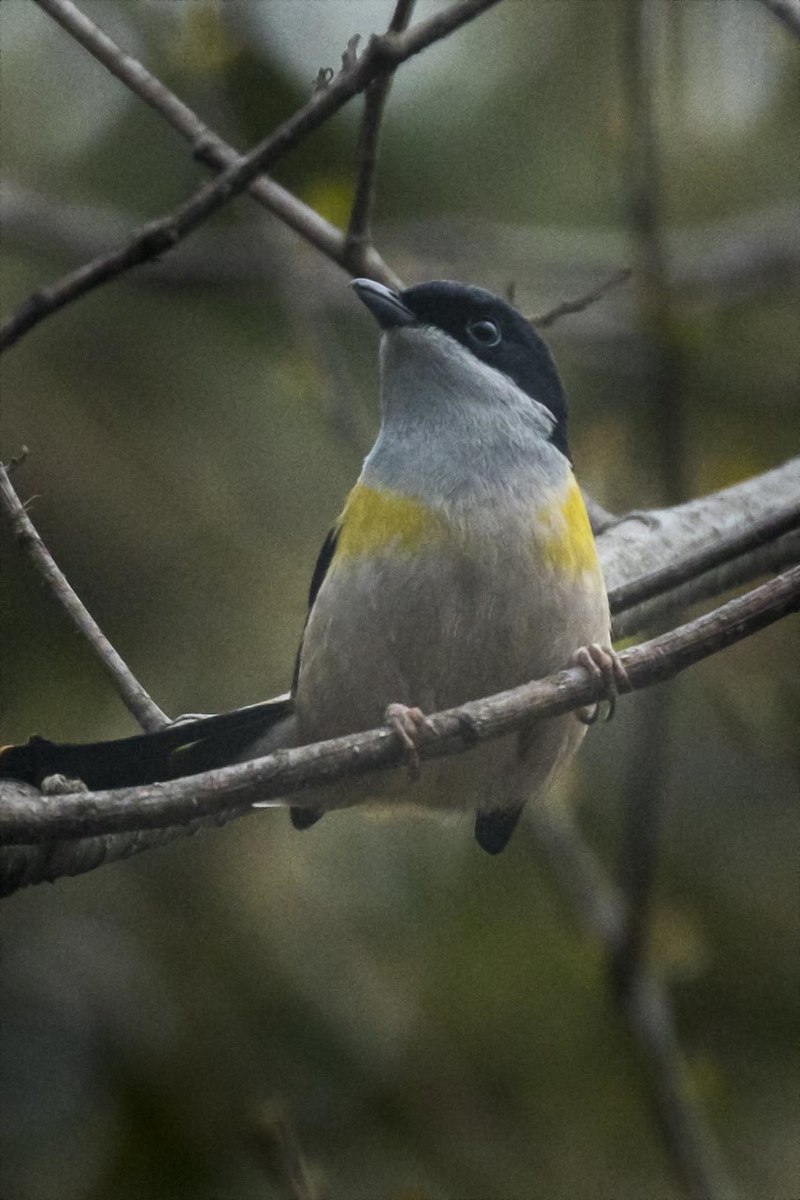
The Black-headed shrike-babbler is a small and beautiful bird found in the forests of eastern Nepal to northwestern Vietnam.
It belongs to either Old World babblers, Timaliidae family or Eurasian vireos, Vireonidae family.
This species inhabits subtropical or tropical moist montane forests which are rich with vegetation and food sources for it.
Its head has an attractive black colouration while its body is covered in brown feathers having white spots on them.
The diet of this bird consists mainly of insects such as beetles, caterpillars, grasshoppers etc., but it also feeds on fruits occasionally too.
In recent years due to deforestation their numbers have been decreasing rapidly so they are listed under Near Threatened status by IUCN Red List conservation programScientific classification:
| Kingdom | Animalia |
| Phylum | Chordata |
| Class | Aves |
| Order | Passeriformes |
| Family | Vireonidae |
| Genus | Pteruthius |
| Species | P. rufiventer |
17. Himalayan Swiftlet
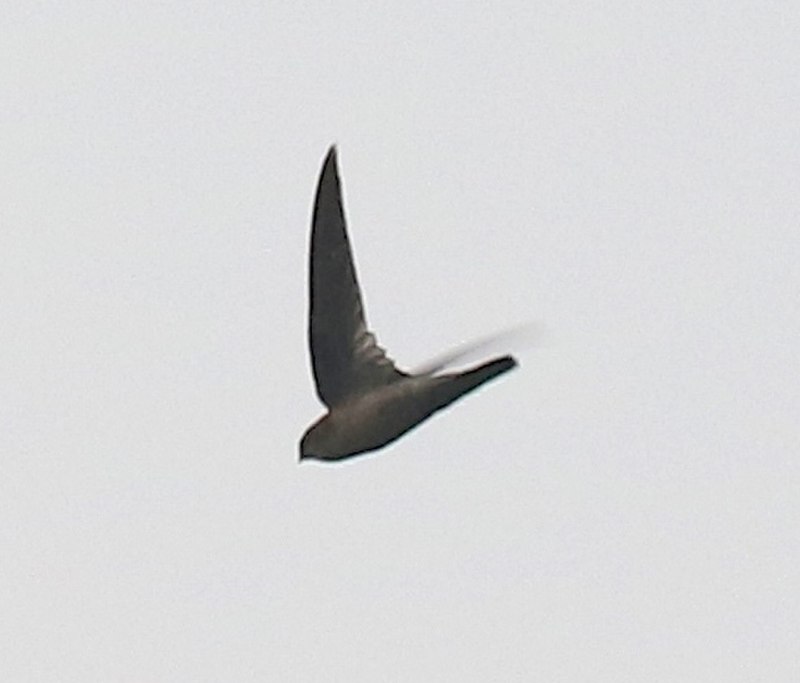
The Himalayan swiftlet is a small species of swift found in the Himalayas and Southeast Asia. It typically lives in colonies, and some populations are migratory.
Its five subspecies have been debated as two separate full species; Indochinese Swiftlets (Aerodramus rogersi) and Javan Swiftlets ( Aerodramus vulcan).
This agile bird has long wings which help it to fly quickly through its mountainous environment, capturing insects on the wing with its wide open beak.
It nests mostly inside caves or crevices, using saliva to build cup-shaped structures for eggs or chicks.
The Himalayan Swiftlet plays an important role in their habitat by controlling insect numbers while providing food sources for other animals such as bats, martens and birds of prey.Scientific classification:
| Kingdom | Animalia |
| Phylum | Chordata |
| Class | Aves |
| Order | Apodiformes |
| Family | Apodidae |
| Genus | Aerodramus |
| Species | A. brevirostris |
Also Featured In: Swifts Species,
18. Great Barbet
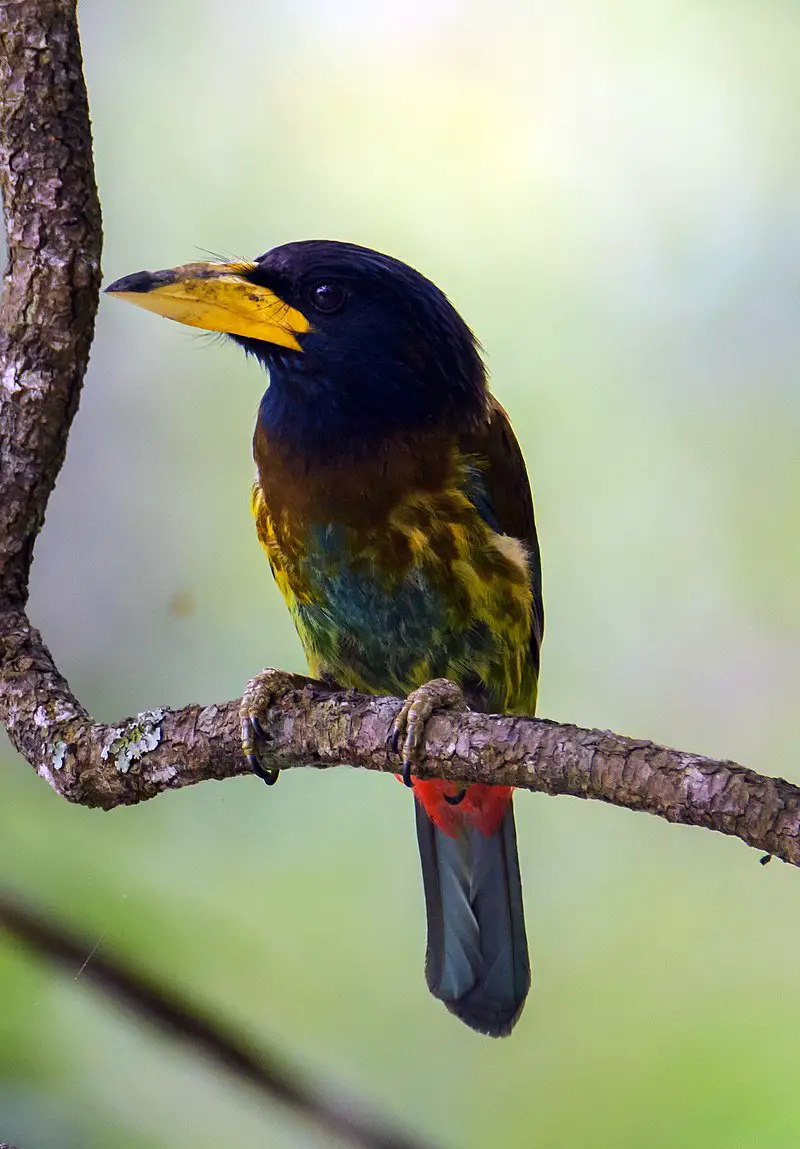
The Great Barbet is a bird species that is indigenous to the Indian subcontinent and Southeast Asia. It mainly resides in forests situated up to 3,000 meters above sea level.
This bird has an attractive and colorful appearance and is a common sight in the region. Its scientific name was suggested as Bucco virens in 1783 by Pieter Boddaert.
Despite being listed as Least Concern on IUCN’s Red List, these birds still face threats from habitat loss and hunting.
The Great Barbet’s wide distribution across its natural range allows it to survive and continue to thrive, making it an important part of the region’s ecosystem.Scientific classification:
| Kingdom | Animalia |
| Phylum | Chordata |
| Class | Aves |
| Order | Piciformes |
| Family | Megalaimidae |
| Genus | Psilopogon |
| Species | P. virens |
Also Featured In: Hong Kong Birds You Need to See, Birds that Live in Uttarakhand
19. Small Minivet
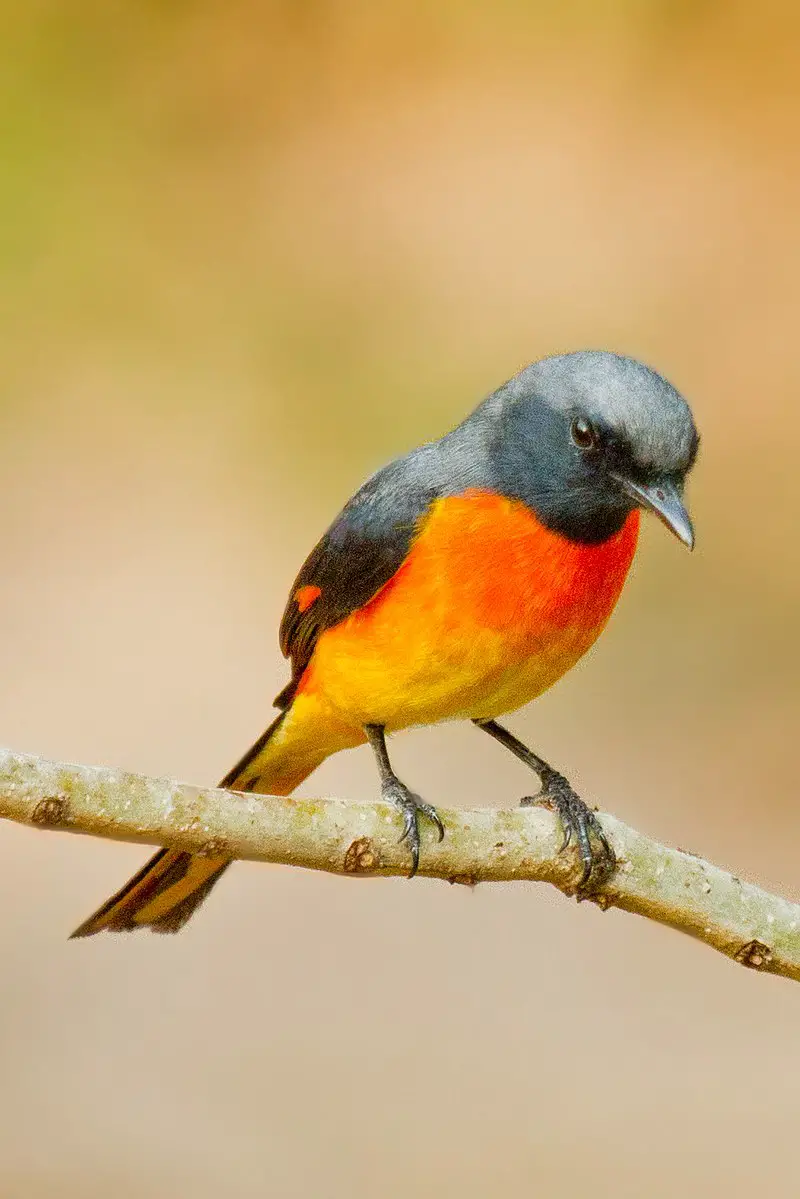
The small minivet bird is a passerine species found in tropical southern Asia. It measures around 16cm in length with a robust dark beak and long wings.
Male small minivets differ from other common minivet species by having grey upperparts and head, and orange underparts that fade to yellow on the belly. This bird can be commonly found from the Indian subcontinent to Indonesia.
Even though the small minivet is a small bird, it is quite remarkable with its distinct features and colorful plumage. Its strong beak helps build intricate nests used to raise their young ones.
Despite its small size, the small minivet plays an essential role in maintaining the ecological balance of their habitat.
Overall, the small minivet is a fascinating species and an excellent example of the diverse and beautiful avian life found in Asia.Scientific classification:
| Kingdom | Animalia |
| Phylum | Chordata |
| Class | Aves |
| Order | Passeriformes |
| Family | Campephagidae |
| Genus | Pericrocotus |
| Species | P. cinnamomeus |
Also Featured In: Gujarati Birds, Common Birds in Bangalore
20. Long-Tailed Minivet
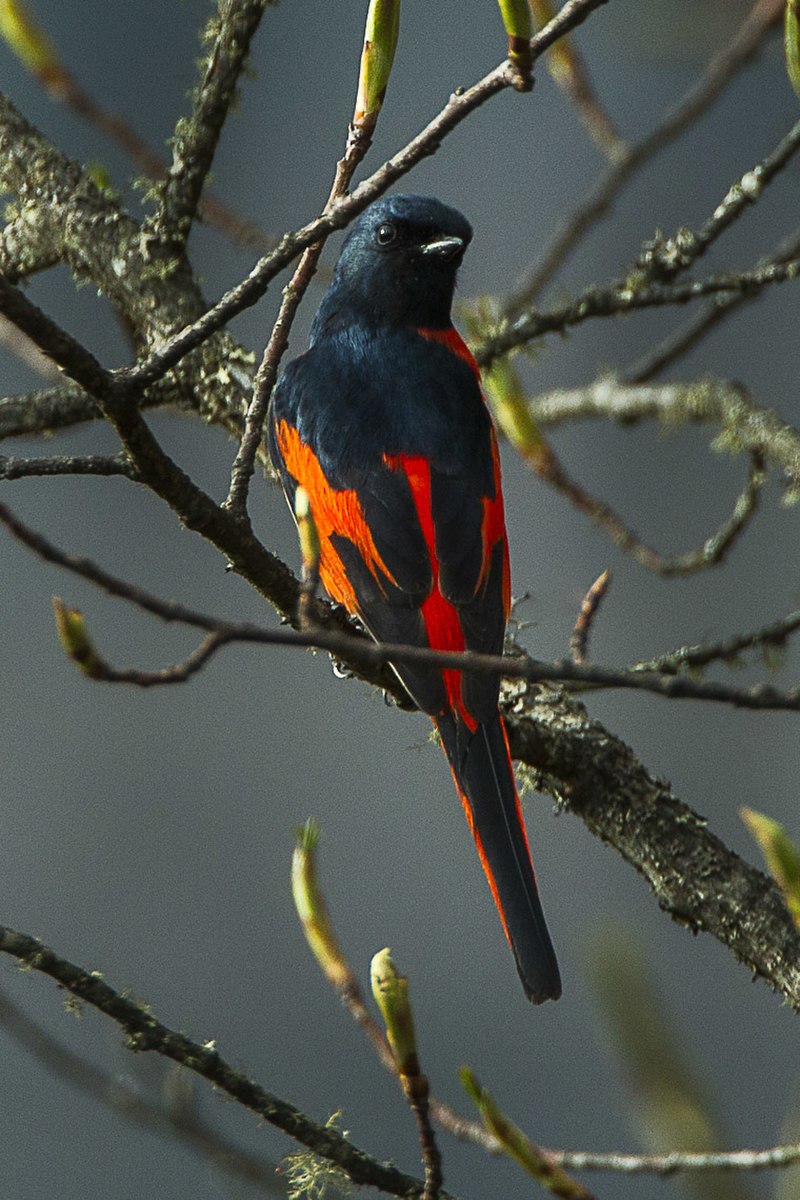
The Long-tailed Minivet is a colorful bird that can be found in southern and southeast Asia. Its striking plumage is a mix of black, white, and fiery orange-red hues, making it easy to spot in its natural habitats of moist lowland and montane forests.
This bird can be found in countries like Afghanistan, Bangladesh, and Vietnam, among others.
The Long-tailed Minivet belongs to the family Campephagidae and has an elongated tail, which is a prominent feature that gives it its name. Its diet mainly consists of insects, which it catches while in flight.
The males have more vibrant plumage compared to the females, and they are known to be vocal birds that make loud, melodious calls.
These birds are fascinating to observe in the wild and are a delight to many bird-watchers around the world.Scientific classification:
| Kingdom | Animalia |
| Phylum | Chordata |
| Class | Aves |
| Order | Passeriformes |
| Family | Campephagidae |
| Genus | Pericrocotus |
| Species | P. ethologus |
Also Featured In: Delhi Birds You Need to See,
21. Red-Headed Trogon
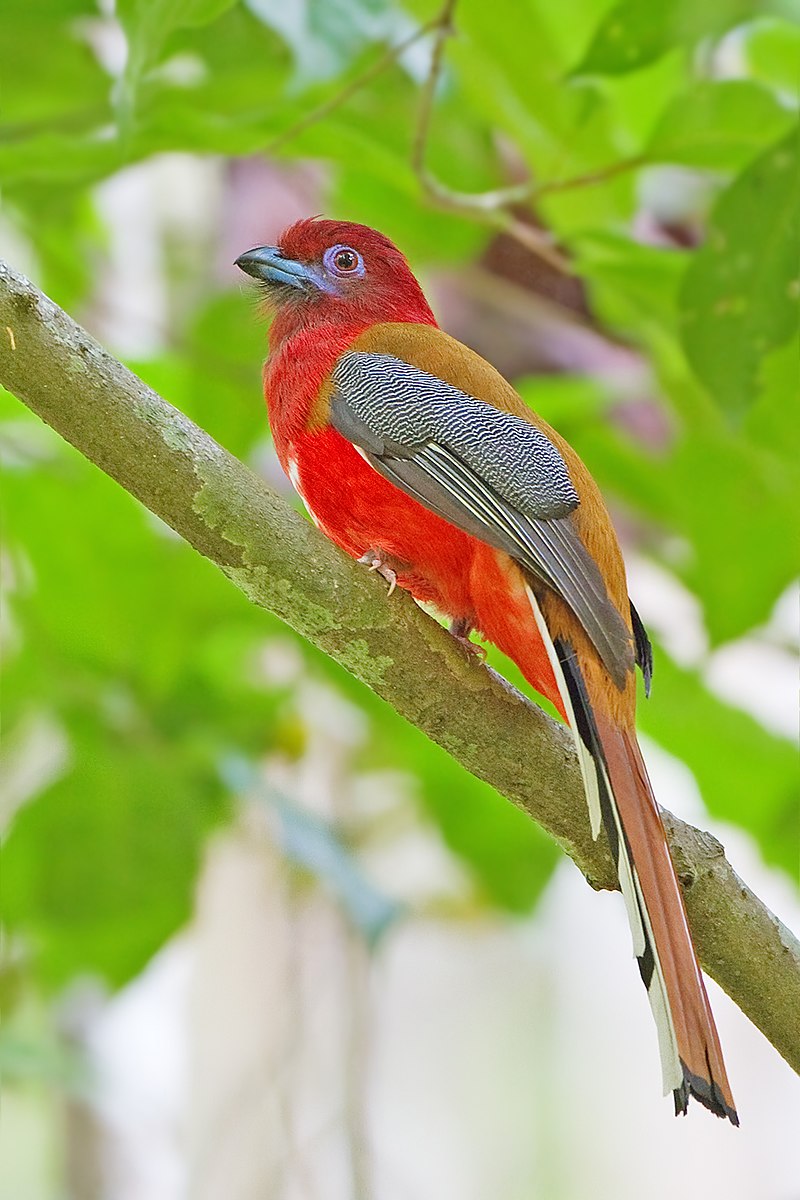
The Red-headed trogon is a bird that belongs to the Trogonidae family. The name of the bird comes from the Greek words ‘eruthros’ meaning red and ‘kephalē’ meaning head.
The male bird has a unique feature with a red head and breast. The Red-headed trogon has an average length of 34 cm. The female of this bird bears a resemblance to Diard’s trogon.Scientific classification:
| Kingdom | Animalia |
| Phylum | Chordata |
| Class | Aves |
| Order | Trogoniformes |
| Family | Trogonidae |
| Genus | Harpactes |
| Species | H. erythrocephalus |
Also Featured In: Birds of Khao Yai National Park, Common Birds of Hainan
22. Barred Cuckoo-Dove
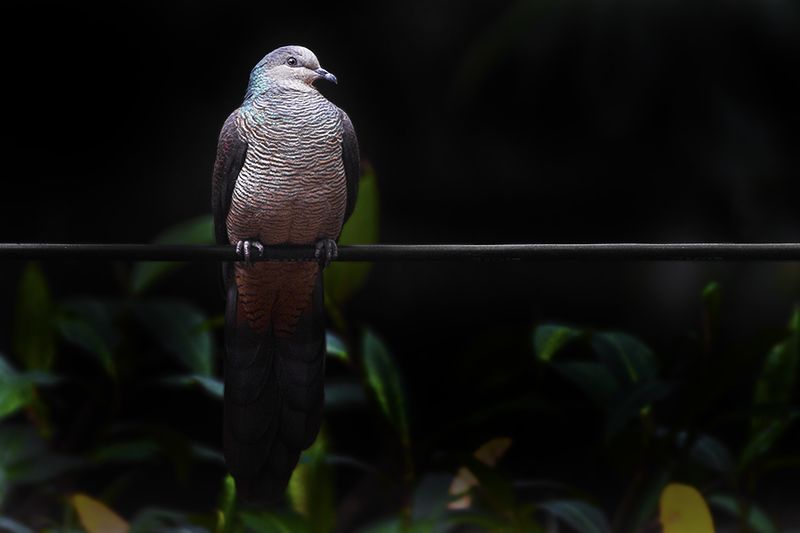
The barred cuckoo-dove is a bird found in South and Southeast Asia. It is a member of the Columbidae family and is considered Least Concern by the IUCN Red List.
The bird was first identified by Johann Georg Wagler in 1827 and has three known subspecies. Its throat and forehead are buff-colored, which becomes pinkish-grey.Scientific classification:
| Kingdom | Animalia |
| Phylum | Chordata |
| Class | Aves |
| Order | Columbiformes |
| Family | Columbidae |
| Genus | Macropygia |
| Species | M. unchall |
Also Featured In: Common Birds of Indonesia,
23. Sclater’s Monal
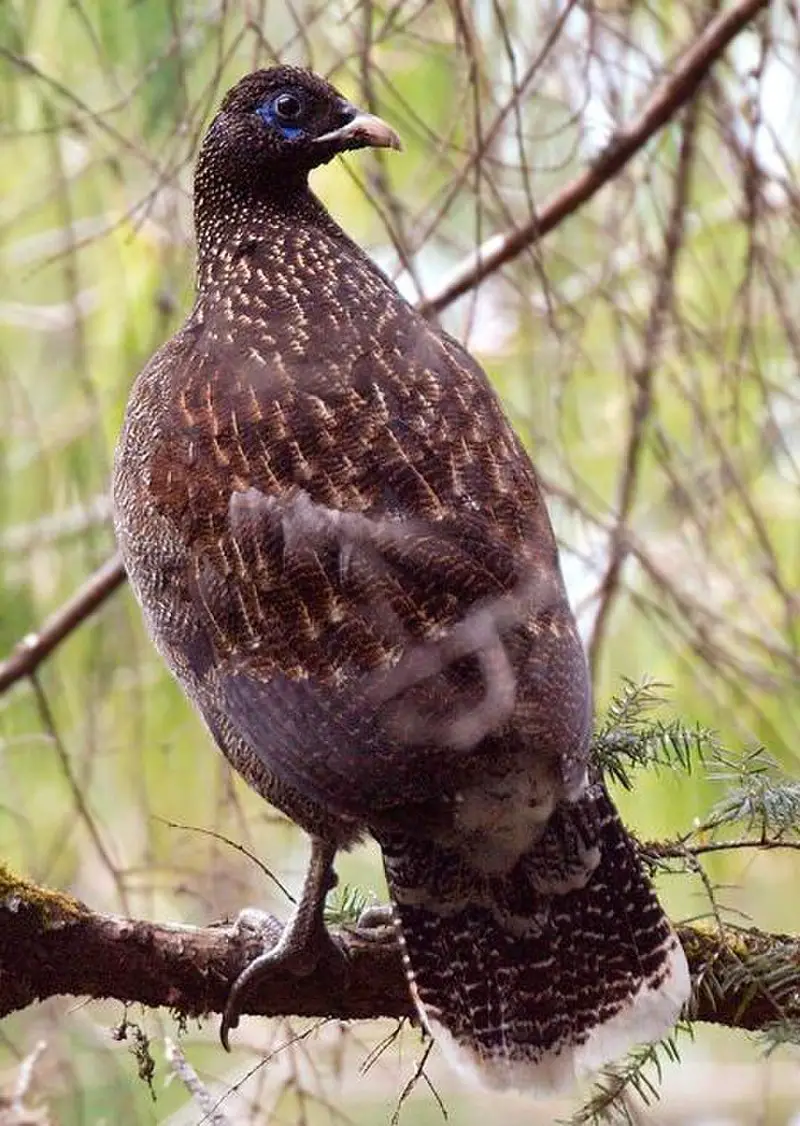
Sclater’s monal, or the crestless monal, is a Himalayan pheasant named after the British zoologist Philip Lutley Sclater. This bird has three recognized subspecies and is approximately 68 centimeters long.
The male is the more colorful of the species, with iridescent purplish-green feathers.Scientific classification:
| Kingdom | Animalia |
| Phylum | Chordata |
| Class | Aves |
| Order | Galliformes |
| Family | Phasianidae |
| Genus | Lophophorus |
| Species | L. sclateri |
24. Wedge-Tailed Green Pigeon
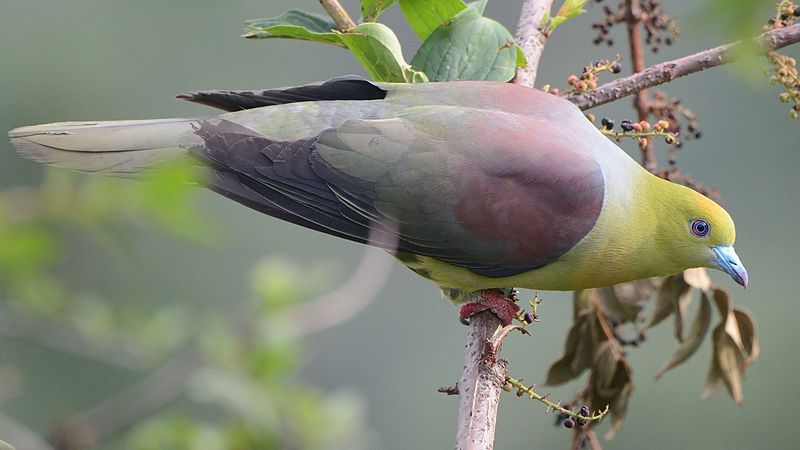
The Wedge-tailed green pigeon, also known as Kokla green pigeon, is a bird from the Columbidae family. It has a distinctive wedge-shaped tail and greenish yellow feathers.
The male has maroon on its back and scapulars, with an orange-rufous tint on its crown. The female lacks these features.
This species is indigenous to the Indian Subcontinent and Southeast Asia, including Bangladesh, Bhutan, Cambodia, and India.
It is a common sight in the region and can be found in forests, gardens, and cities alike. These birds generally feed on fruits and grains and are known to form flocks.
Interestingly, the Wedge-tailed green pigeon is considered one of the few bird species that are long-distance frugivores, as their diet mainly consists of fruit from trees that are several hundred meters apart.Scientific classification:
| Kingdom | Animalia |
| Phylum | Chordata |
| Class | Aves |
| Order | Columbiformes |
| Family | Columbidae |
| Genus | Treron |
| Species | T. sphenurus |
Also Featured In: Common Birds of Lombok,
25. Solitary Snipe
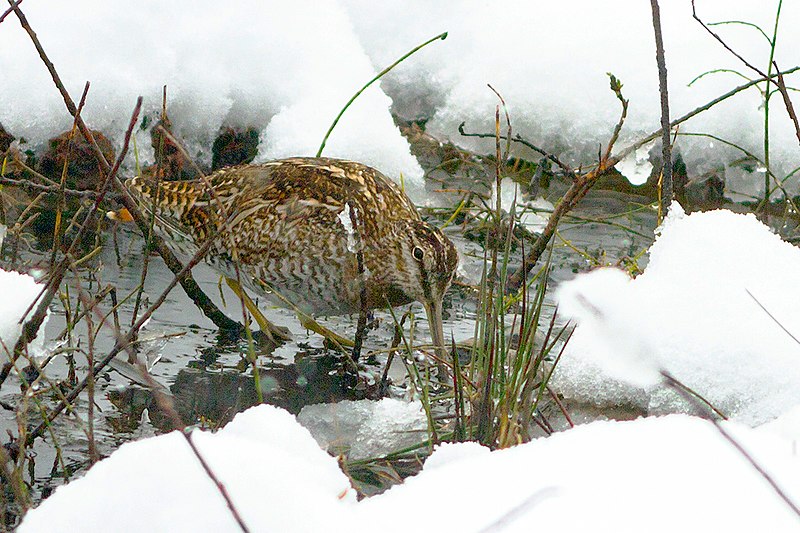
The Solitary snipe bird is a wader that can be found in the Palearctic region, specifically from northeast Iran to Japan and Korea.
It has a stocky body, measuring 29-31 cm in length, and relatively short legs compared to other waders.
The bird’s upperparts, head, and neck have streaks and patterns of medium brown stripes with whitish edges, forming lines down its back.
Its face is white with a dark stripe through the eye. The bird’s habitat includes marshes, bogs, and wet grasslands near water.
It is an active bird that feeds on small invertebrates, and its distinctive call sounds like a repeated “tsoowick.”
The Solitary snipe is a relatively unknown species but plays an essential role in the ecosystems where it resides.Scientific classification:
| Kingdom | Animalia |
| Phylum | Chordata |
| Class | Aves |
| Order | Charadriiformes |
| Family | Scolopacidae |
| Genus | Gallinago |
| Species | G. solitaria |
26. Green Shrike-Babbler
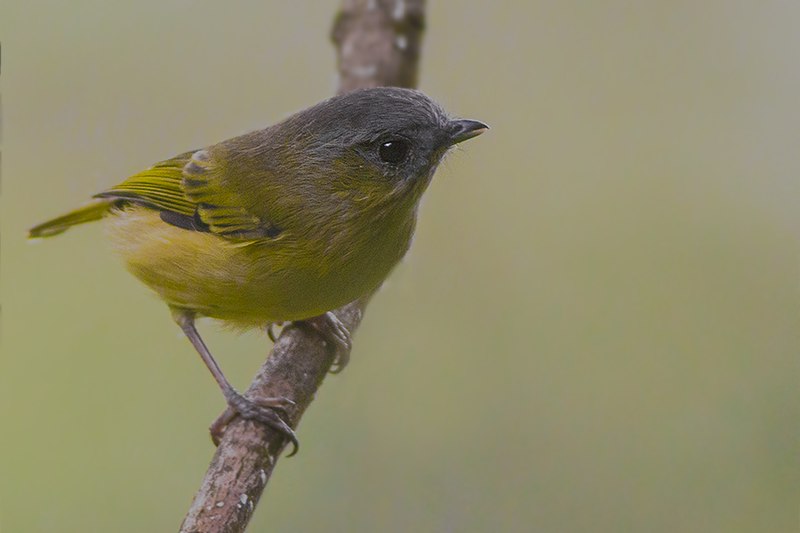
The Green shrike-babbler is a small bird, measuring approximately 13 centimeters in length. The male of this species boasts a grey head with olive-green on its back.
Its throat and breast are a pale ashy grey color. The Green shrike-babbler was previously categorized under the Timaliidae family, but is now considered an Asian offshoot of the American vireos and belongs to the Vireonidae family.Scientific classification:
| Kingdom | Animalia |
| Phylum | Chordata |
| Class | Aves |
| Order | Passeriformes |
| Family | Vireonidae |
| Genus | Pteruthius |
| Species | P. xanthochlorus |
27. Short-Billed Minivet
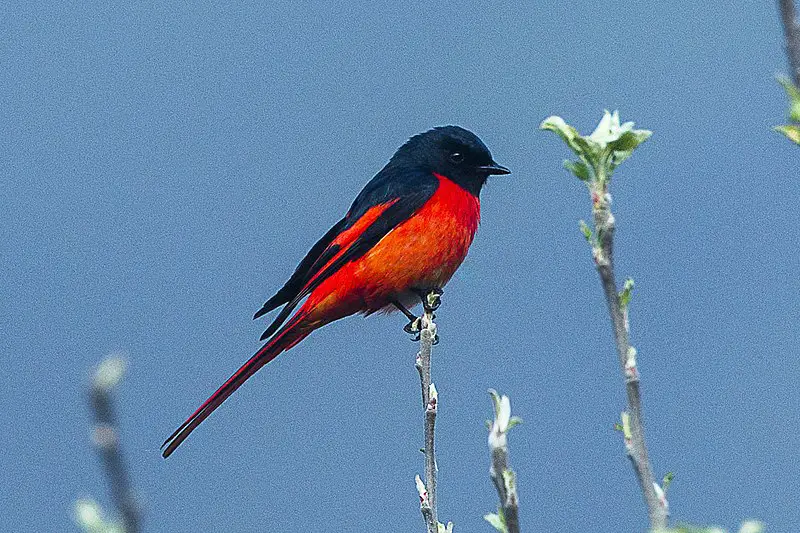
The Short-billed minivet is a small bird that belongs to the family Campephagidae. It can be found in various countries like China, Nepal and India.
Living mainly in subtropical or tropical moist lowland forests and montane forests, it has adapted to these habitats over time.
With its unique features like a small bill, it has managed to survive in these areas. The bird’s distinct plumage and coloration make it easy to identify and appreciate its beauty.
Though small in size, it plays an important part in the ecosystem, helping in the pollination of plants and being a food source for predators.
Its presence adds to the richness of biodiversity in the region.
Overall, the Short-billed minivet is a wonderful testament of nature’s ability to adapt and thrive in different environments.Scientific classification:
| Kingdom | Animalia |
| Phylum | Chordata |
| Class | Aves |
| Order | Passeriformes |
| Family | Campephagidae |
| Genus | Pericrocotus |
| Species | P. brevirostris |